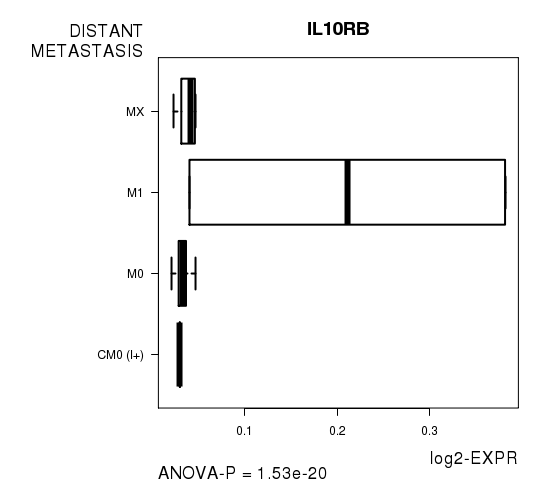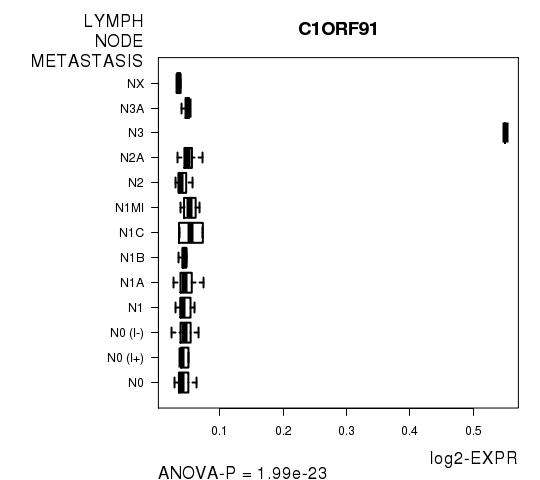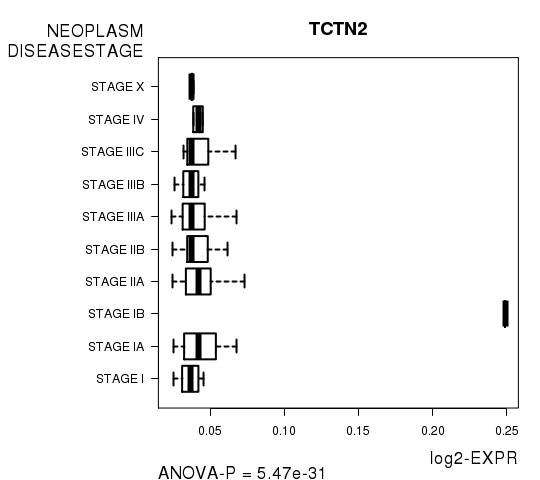This pipeline uses various statistical tests to identify genes whose promoter methylation levels correlated to selected clinical features.
Testing the association between 15521 genes and 16 clinical features across 238 samples, statistically thresholded by Q value < 0.05, 9 clinical features related to at least one genes.
-
21 genes correlated to 'Time to Death'.
-
LGALS4 , ALG3 , TEX101 , VIL1 , PPY2 , ...
-
6 genes correlated to 'AGE'.
-
FAM123C , C7ORF13 , KIF15 , TSPYL5 , BOC , ...
-
5145 genes correlated to 'PRIMARY.SITE.OF.DISEASE'.
-
ZNF416 , BBS10 , AGK , SYNGR1 , HERPUD2 , ...
-
332 genes correlated to 'GENDER'.
-
CDKL2 , ZNF295 , UTP14C , GLIPR1L1 , TBC1D24 , ...
-
3669 genes correlated to 'HISTOLOGICAL.TYPE'.
-
ZNF419 , EPM2AIP1 , MED12L , BBS10 , ZNF416 , ...
-
19 genes correlated to 'RADIATIONS.RADIATION.REGIMENINDICATION'.
-
DEPDC4 , ZFAND6 , SLC39A5 , SMAD4 , PIP4K2C , ...
-
46 genes correlated to 'DISTANT.METASTASIS'.
-
IL10RB , JOSD2 , ATP2B2 , NHEDC1 , GOLGA1 , ...
-
51 genes correlated to 'LYMPH.NODE.METASTASIS'.
-
C1ORF91 , KIAA1841 , TMEM33 , RG9MTD1 , LDLRAP1 , ...
-
29 genes correlated to 'NEOPLASM.DISEASESTAGE'.
-
TCTN2 , HIST1H4C , UGT2B4 , ART4 , IL10RB , ...
-
No genes correlated to 'PATHOLOGY.T', 'PATHOLOGY.N', 'TUMOR.STAGE', 'NUMBERPACKYEARSSMOKED', 'TOBACCOSMOKINGHISTORYINDICATOR', 'YEAROFTOBACCOSMOKINGONSET', and 'NUMBER.OF.LYMPH.NODES'.
Complete statistical result table is provided in Supplement Table 1
Table 1. Get Full Table This table shows the clinical features, statistical methods used, and the number of genes that are significantly associated with each clinical feature at Q value < 0.05.
| Clinical feature | Statistical test | Significant genes | Associated with | Associated with | ||
|---|---|---|---|---|---|---|
| Time to Death | Cox regression test | N=21 | shorter survival | N=0 | longer survival | N=21 |
| AGE | Spearman correlation test | N=6 | older | N=6 | younger | N=0 |
| PRIMARY SITE OF DISEASE | ANOVA test | N=5145 | ||||
| GENDER | t test | N=332 | male | N=66 | female | N=266 |
| HISTOLOGICAL TYPE | ANOVA test | N=3669 | ||||
| PATHOLOGY T | Spearman correlation test | N=0 | ||||
| PATHOLOGY N | Spearman correlation test | N=0 | ||||
| TUMOR STAGE | Spearman correlation test | N=0 | ||||
| RADIATIONS RADIATION REGIMENINDICATION | t test | N=19 | yes | N=6 | no | N=13 |
| NUMBERPACKYEARSSMOKED | Spearman correlation test | N=0 | ||||
| TOBACCOSMOKINGHISTORYINDICATOR | ANOVA test | N=0 | ||||
| YEAROFTOBACCOSMOKINGONSET | Spearman correlation test | N=0 | ||||
| DISTANT METASTASIS | ANOVA test | N=46 | ||||
| LYMPH NODE METASTASIS | ANOVA test | N=51 | ||||
| NUMBER OF LYMPH NODES | Spearman correlation test | N=0 | ||||
| NEOPLASM DISEASESTAGE | ANOVA test | N=29 |
Table S1. Basic characteristics of clinical feature: 'Time to Death'
| Time to Death | Duration (Months) | 0.1-223.4 (median=29.1) |
| censored | N = 194 | |
| death | N = 40 | |
| Significant markers | N = 21 | |
| associated with shorter survival | 0 | |
| associated with longer survival | 21 |
Table S2. Get Full Table List of top 10 genes significantly associated with 'Time to Death' by Cox regression test
| HazardRatio | Wald_P | Q | C_index | |
|---|---|---|---|---|
| LGALS4 | 0 | 1.372e-08 | 0.00021 | 0.269 |
| ALG3 | 0 | 8.947e-08 | 0.0014 | 0.263 |
| TEX101 | 0 | 8.948e-08 | 0.0014 | 0.32 |
| VIL1 | 0.01 | 1.447e-07 | 0.0022 | 0.337 |
| PPY2 | 0 | 1.611e-07 | 0.0025 | 0.342 |
| APOC2 | 0.01 | 1.989e-07 | 0.0031 | 0.341 |
| TNNT2 | 0 | 2.96e-07 | 0.0046 | 0.335 |
| PTGDS | 0 | 4.373e-07 | 0.0068 | 0.342 |
| ADCK5 | 0 | 4.438e-07 | 0.0069 | 0.331 |
| PTP4A3 | 0 | 4.442e-07 | 0.0069 | 0.338 |
Figure S1. Get High-res Image As an example, this figure shows the association of LGALS4 to 'Time to Death'. four curves present the cumulative survival rates of 4 quartile subsets of patients. P value = 1.37e-08 with univariate Cox regression analysis using continuous log-2 expression values.

Table S3. Basic characteristics of clinical feature: 'AGE'
| AGE | Mean (SD) | 56.59 (13) |
| Significant markers | N = 6 | |
| pos. correlated | 6 | |
| neg. correlated | 0 |
Table S4. Get Full Table List of 6 genes significantly correlated to 'AGE' by Spearman correlation test
| SpearmanCorr | corrP | Q | |
|---|---|---|---|
| FAM123C | 0.33 | 2.11e-07 | 0.00328 |
| C7ORF13 | 0.3178 | 6.151e-07 | 0.00955 |
| KIF15 | 0.315 | 7.841e-07 | 0.0122 |
| TSPYL5 | 0.3113 | 1.067e-06 | 0.0166 |
| BOC | 0.3111 | 1.089e-06 | 0.0169 |
| HNRNPC | 0.3012 | 2.707e-06 | 0.042 |
Figure S2. Get High-res Image As an example, this figure shows the association of FAM123C to 'AGE'. P value = 2.11e-07 with Spearman correlation analysis. The straight line presents the best linear regression.

Table S5. Basic characteristics of clinical feature: 'PRIMARY.SITE.OF.DISEASE'
| PRIMARY.SITE.OF.DISEASE | Labels | N |
| BREAST | 214 | |
| COLON | 1 | |
| KIDNEY | 2 | |
| LUNG | 20 | |
| RECTUM | 1 | |
| Significant markers | N = 5145 |
Table S6. Get Full Table List of top 10 genes differentially expressed by 'PRIMARY.SITE.OF.DISEASE'
| ANOVA_P | Q | |
|---|---|---|
| ZNF416 | 1.01e-243 | 1.57e-239 |
| BBS10 | 1.016e-224 | 1.58e-220 |
| AGK | 1.598e-223 | 2.48e-219 |
| SYNGR1 | 1.037e-214 | 1.61e-210 |
| HERPUD2 | 3.057e-209 | 4.74e-205 |
| C20ORF194 | 1.437e-195 | 2.23e-191 |
| PARD6G | 5.208e-188 | 8.08e-184 |
| RAB6B | 1.442e-165 | 2.24e-161 |
| MEIS3 | 5.212e-161 | 8.09e-157 |
| RDX | 8.948e-156 | 1.39e-151 |
Figure S3. Get High-res Image As an example, this figure shows the association of ZNF416 to 'PRIMARY.SITE.OF.DISEASE'. P value = 1.01e-243 with ANOVA analysis.

Table S7. Basic characteristics of clinical feature: 'GENDER'
| GENDER | Labels | N |
| FEMALE | 222 | |
| MALE | 16 | |
| Significant markers | N = 332 | |
| Higher in MALE | 66 | |
| Higher in FEMALE | 266 |
Table S8. Get Full Table List of top 10 genes differentially expressed by 'GENDER'
| T(pos if higher in 'MALE') | ttestP | Q | AUC | |
|---|---|---|---|---|
| CDKL2 | -16.25 | 2.559e-40 | 3.97e-36 | 0.8705 |
| ZNF295 | -13.25 | 5.311e-28 | 8.24e-24 | 0.8756 |
| UTP14C | 18.1 | 3.502e-26 | 5.44e-22 | 0.9428 |
| GLIPR1L1 | -10.29 | 1.166e-20 | 1.81e-16 | 0.877 |
| TBC1D24 | 11.6 | 5.696e-20 | 8.84e-16 | 0.8694 |
| SLC35E2 | 10.08 | 7.628e-20 | 1.18e-15 | 0.6765 |
| LRIG3 | -9.83 | 2.76e-19 | 4.28e-15 | 0.8218 |
| IRF9 | 11.24 | 4.911e-19 | 7.62e-15 | 0.8156 |
| TMED3 | 10.44 | 1.72e-18 | 2.67e-14 | 0.7897 |
| BAT2 | 10.82 | 2.581e-18 | 4e-14 | 0.8528 |
Figure S4. Get High-res Image As an example, this figure shows the association of CDKL2 to 'GENDER'. P value = 2.56e-40 with T-test analysis.

Table S9. Basic characteristics of clinical feature: 'HISTOLOGICAL.TYPE'
| HISTOLOGICAL.TYPE | Labels | N |
| COLON ADENOCARCINOMA | 1 | |
| INFILTRATING DUCTAL CARCINOMA | 35 | |
| INFILTRATING LOBULAR CARCINOMA | 5 | |
| KIDNEY CLEAR CELL RENAL CARCINOMA | 2 | |
| LUNG BASALOID SQUAMOUS CELL CARCINOMA | 2 | |
| LUNG SQUAMOUS CELL CARCINOMA- NOT OTHERWISE SPECIFIED (NOS) | 18 | |
| MIXED HISTOLOGY (PLEASE SPECIFY) | 3 | |
| OTHER SPECIFY | 3 | |
| RECTAL ADENOCARCINOMA | 1 | |
| Significant markers | N = 3669 |
Table S10. Get Full Table List of top 10 genes differentially expressed by 'HISTOLOGICAL.TYPE'
| ANOVA_P | Q | |
|---|---|---|
| ZNF419 | 2.022e-110 | 3.14e-106 |
| EPM2AIP1 | 1.18e-98 | 1.83e-94 |
| MED12L | 3.038e-97 | 4.71e-93 |
| BBS10 | 1.237e-93 | 1.92e-89 |
| ZNF416 | 2.196e-89 | 3.41e-85 |
| C2ORF52 | 5.712e-89 | 8.86e-85 |
| C6ORF129 | 2.893e-88 | 4.49e-84 |
| AGK | 5.105e-88 | 7.92e-84 |
| HERPUD2 | 3.7e-84 | 5.74e-80 |
| CRH | 3.238e-77 | 5.02e-73 |
Figure S5. Get High-res Image As an example, this figure shows the association of ZNF419 to 'HISTOLOGICAL.TYPE'. P value = 2.02e-110 with ANOVA analysis.

Table S11. Basic characteristics of clinical feature: 'PATHOLOGY.T'
| PATHOLOGY.T | Mean (SD) | 1.96 (0.86) |
| N | ||
| T1 | 7 | |
| T2 | 13 | |
| T3 | 2 | |
| T4 | 2 | |
| Significant markers | N = 0 |
Table S12. Basic characteristics of clinical feature: 'PATHOLOGY.N'
| PATHOLOGY.N | Mean (SD) | 0.5 (0.67) |
| N | ||
| N0 | 13 | |
| N1 | 7 | |
| N2 | 2 | |
| Significant markers | N = 0 |
Table S13. Basic characteristics of clinical feature: 'TUMOR.STAGE'
| TUMOR.STAGE | Mean (SD) | 1.79 (0.88) |
| N | ||
| Stage 1 | 11 | |
| Stage 2 | 8 | |
| Stage 3 | 4 | |
| Stage 4 | 1 | |
| Significant markers | N = 0 |
19 genes related to 'RADIATIONS.RADIATION.REGIMENINDICATION'.
Table S14. Basic characteristics of clinical feature: 'RADIATIONS.RADIATION.REGIMENINDICATION'
| RADIATIONS.RADIATION.REGIMENINDICATION | Labels | N |
| NO | 79 | |
| YES | 159 | |
| Significant markers | N = 19 | |
| Higher in YES | 6 | |
| Higher in NO | 13 |
Table S15. Get Full Table List of top 10 genes differentially expressed by 'RADIATIONS.RADIATION.REGIMENINDICATION'
| T(pos if higher in 'YES') | ttestP | Q | AUC | |
|---|---|---|---|---|
| DEPDC4 | -5.99 | 1.358e-08 | 0.000211 | 0.7293 |
| ZFAND6 | -5.99 | 1.44e-08 | 0.000223 | 0.746 |
| SLC39A5 | -5.4 | 1.79e-07 | 0.00278 | 0.6896 |
| SMAD4 | -5.4 | 2.379e-07 | 0.00369 | 0.7004 |
| PIP4K2C | -5.34 | 2.914e-07 | 0.00452 | 0.7163 |
| BNIP2 | -5.32 | 3.194e-07 | 0.00496 | 0.6945 |
| C18ORF8 | -5.23 | 5.995e-07 | 0.0093 | 0.7098 |
| SBK1 | -5.16 | 6.828e-07 | 0.0106 | 0.6853 |
| CDC27 | -5.11 | 9.06e-07 | 0.0141 | 0.6959 |
| LCAT | -5 | 1.247e-06 | 0.0193 | 0.6848 |
Figure S6. Get High-res Image As an example, this figure shows the association of DEPDC4 to 'RADIATIONS.RADIATION.REGIMENINDICATION'. P value = 1.36e-08 with T-test analysis.

Table S16. Basic characteristics of clinical feature: 'NUMBERPACKYEARSSMOKED'
| NUMBERPACKYEARSSMOKED | Mean (SD) | 54.79 (42) |
| Significant markers | N = 0 |
No gene related to 'TOBACCOSMOKINGHISTORYINDICATOR'.
Table S17. Basic characteristics of clinical feature: 'TOBACCOSMOKINGHISTORYINDICATOR'
| TOBACCOSMOKINGHISTORYINDICATOR | Labels | N |
| CURRENT REFORMED SMOKER FOR < OR = 15 YEARS | 7 | |
| CURRENT REFORMED SMOKER FOR > 15 YEARS | 6 | |
| CURRENT SMOKER | 7 | |
| Significant markers | N = 0 |
Table S18. Basic characteristics of clinical feature: 'YEAROFTOBACCOSMOKINGONSET'
| YEAROFTOBACCOSMOKINGONSET | Mean (SD) | 1956.38 (6.9) |
| Significant markers | N = 0 |
Table S19. Basic characteristics of clinical feature: 'DISTANT.METASTASIS'
| DISTANT.METASTASIS | Labels | N |
| CM0 (I+) | 1 | |
| M0 | 160 | |
| M1 | 2 | |
| MX | 5 | |
| Significant markers | N = 46 |
Table S20. Get Full Table List of top 10 genes differentially expressed by 'DISTANT.METASTASIS'
| ANOVA_P | Q | |
|---|---|---|
| IL10RB | 1.533e-20 | 2.38e-16 |
| JOSD2 | 5.81e-19 | 9.02e-15 |
| ATP2B2 | 3.268e-12 | 5.07e-08 |
| NHEDC1 | 1.316e-11 | 2.04e-07 |
| GOLGA1 | 1.828e-11 | 2.84e-07 |
| MRPS12 | 2.209e-11 | 3.43e-07 |
| HUNK | 2.705e-10 | 4.2e-06 |
| RBM23 | 7.483e-10 | 1.16e-05 |
| TINF2 | 2.463e-09 | 3.82e-05 |
| NDEL1 | 9.759e-09 | 0.000151 |
Figure S7. Get High-res Image As an example, this figure shows the association of IL10RB to 'DISTANT.METASTASIS'. P value = 1.53e-20 with ANOVA analysis.

Table S21. Basic characteristics of clinical feature: 'LYMPH.NODE.METASTASIS'
| LYMPH.NODE.METASTASIS | Labels | N |
| N0 | 32 | |
| N0 (I+) | 5 | |
| N0 (I-) | 32 | |
| N1 | 18 | |
| N1A | 28 | |
| N1B | 10 | |
| N1C | 2 | |
| N1MI | 4 | |
| N2 | 15 | |
| N2A | 14 | |
| N3 | 1 | |
| N3A | 5 | |
| NX | 2 | |
| Significant markers | N = 51 |
Table S22. Get Full Table List of top 10 genes differentially expressed by 'LYMPH.NODE.METASTASIS'
| ANOVA_P | Q | |
|---|---|---|
| C1ORF91 | 1.987e-23 | 3.08e-19 |
| KIAA1841 | 1.077e-19 | 1.67e-15 |
| TMEM33 | 1.594e-11 | 2.47e-07 |
| RG9MTD1 | 2.155e-11 | 3.34e-07 |
| LDLRAP1 | 2.725e-11 | 4.23e-07 |
| MKRN2 | 3.855e-11 | 5.98e-07 |
| TRAPPC2L | 1.672e-10 | 2.59e-06 |
| CLYBL | 1.185e-09 | 1.84e-05 |
| NUP214 | 1.888e-09 | 2.93e-05 |
| AP3D1 | 1.009e-08 | 0.000157 |
Figure S8. Get High-res Image As an example, this figure shows the association of C1ORF91 to 'LYMPH.NODE.METASTASIS'. P value = 1.99e-23 with ANOVA analysis.

Table S23. Basic characteristics of clinical feature: 'NUMBER.OF.LYMPH.NODES'
| NUMBER.OF.LYMPH.NODES | Mean (SD) | 2.09 (3.4) |
| Significant markers | N = 0 |
Table S24. Basic characteristics of clinical feature: 'NEOPLASM.DISEASESTAGE'
| NEOPLASM.DISEASESTAGE | Labels | N |
| STAGE I | 15 | |
| STAGE IA | 12 | |
| STAGE IB | 1 | |
| STAGE IIA | 53 | |
| STAGE IIB | 36 | |
| STAGE IIIA | 38 | |
| STAGE IIIB | 3 | |
| STAGE IIIC | 5 | |
| STAGE IV | 2 | |
| STAGE X | 3 | |
| Significant markers | N = 29 |
Table S25. Get Full Table List of top 10 genes differentially expressed by 'NEOPLASM.DISEASESTAGE'
| ANOVA_P | Q | |
|---|---|---|
| TCTN2 | 5.469e-31 | 8.49e-27 |
| HIST1H4C | 6.368e-28 | 9.88e-24 |
| UGT2B4 | 1.085e-19 | 1.68e-15 |
| ART4 | 2.216e-17 | 3.44e-13 |
| IL10RB | 2.508e-16 | 3.89e-12 |
| JOSD2 | 8.144e-15 | 1.26e-10 |
| NR0B2 | 2.747e-12 | 4.26e-08 |
| RNF25 | 4.209e-10 | 6.53e-06 |
| ZNF619 | 6.584e-10 | 1.02e-05 |
| ZNF230 | 9.591e-10 | 1.49e-05 |
Figure S9. Get High-res Image As an example, this figure shows the association of TCTN2 to 'NEOPLASM.DISEASESTAGE'. P value = 5.47e-31 with ANOVA analysis.

-
Expresson data file = PANCAN12-TP.meth.for_correlation.filtered_data.txt
-
Clinical data file = PANCAN12-TP.clin.merged.picked.txt
-
Number of patients = 238
-
Number of genes = 15521
-
Number of clinical features = 16
For survival clinical features, Wald's test in univariate Cox regression analysis with proportional hazards model (Andersen and Gill 1982) was used to estimate the P values using the 'coxph' function in R. Kaplan-Meier survival curves were plot using the four quartile subgroups of patients based on expression levels
For continuous numerical clinical features, Spearman's rank correlation coefficients (Spearman 1904) and two-tailed P values were estimated using 'cor.test' function in R
For multi-class clinical features (ordinal or nominal), one-way analysis of variance (Howell 2002) was applied to compare the log2-expression levels between different clinical classes using 'anova' function in R
For two-class clinical features, two-tailed Student's t test with unequal variance (Lehmann and Romano 2005) was applied to compare the log2-expression levels between the two clinical classes using 't.test' function in R
For multiple hypothesis correction, Q value is the False Discovery Rate (FDR) analogue of the P value (Benjamini and Hochberg 1995), defined as the minimum FDR at which the test may be called significant. We used the 'Benjamini and Hochberg' method of 'p.adjust' function in R to convert P values into Q values.
This is an experimental feature. The full results of the analysis summarized in this report can be downloaded from the TCGA Data Coordination Center.